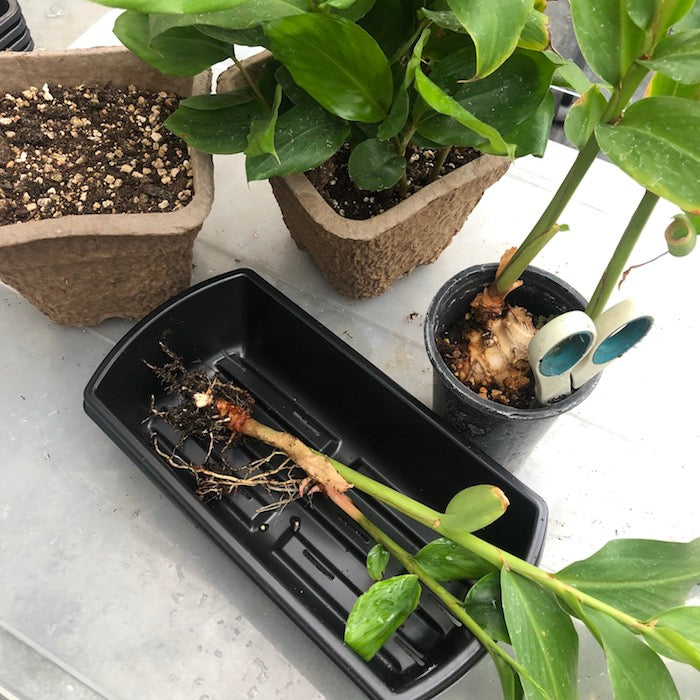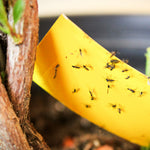Anyone who spends time on food-gardening social media has likely noticed the massive enthusiasm for gingers in the last year or two. After all, this exotic but kitchen-friendly herb is incredibly rewarding to grow in a northern setting!
Most of the attention has been on two species, Zingiber officinale and Curcuma longa - better known as common ginger and turmeric, respectfully. These are awesome plants to grow and can even be started from fresh rhizomes available at organic grocery stores (think back to our Garden Club session on this!). However, they are really summer plants that go fully dormant through the winter when brought indoors. So, I thought it would be fun to share some experience with a couple of alternative culinary gingers that remain evergreen year-round... much more satisfying if you love keeping edible plants indoors through winter.

Classic culinary, Zingiber officinale, as featured on the From Soil to Soul Instagram account this past summer (Maggie, who curates From Soil to Soul, is my co-host on the Grow Guide podcast).
The two plants that you will grow in our third January Pick-Me-up project are Galangal (Alpinia galangal) and White Peacock Ginger (Hedychium coronarium). Both of these plants are incredibly container friendly and easily thrive in most indoor settings without the need for special equipment. Gingers are generally shade-oriented; however, the rule of thumb is that indoors, by nature, has much less brightness compared to outdoors, so even low-light plants such as gingers should be in a space with bright diffuse light for best vigour. Beyond that, these are truly grower-friendly indoor plants.
In terms of using galangal and butterfly gingers as culinary herbs, galangal is strongly associated with Thai and Indonesian cuisine while butterfly ginger has ties to Central American traditions (although actually native to Nepal and neighbouring regions).
Galangal has aromatic leaves and roots; one of our favourite ways to use is by harvesting fresh leaves and adding these to hot teas or ciders, but also for steaming with rice or added to simmering soups.
Butterfly ginger rhizomes are large - but not highly aromatic; it is actually the tropical white flowers and immature buds that are most often harvested for seasoning. Although the bloom time is typically late summer and fall, it is well worth getting your plant established now so you can enjoy the rewards later in the season.

Galangal ginger has either lance or oval-shaped leaves that are highly fragrant. Butterfly ginger has sturdy upright stems and leaves, and the large rhizomes often sit slightly above the soil; the pure white flowers of butterfly ginger are prized for their aroma.
If you have been following our January projects, you will recall that our first Pick-Me-Up focuses on propagating by leaf and stem cuttings, and our second project is all about getting a deeper understanding of seeds; this time you will grow from root divisions. A cool thing about propagation by division is that you are essentially using fully rooted plant pieces... so less stress and uncertainty for you, the grower!

This project starts with us dividing mature galangal and butterfly ginger plants to send home with you! That process is quite straightforward: we un-pot the plants, loosen the soil around the stems by gently tapping, then untangle the natural division points. We usually finish this by slicing joined sections with a sharp knife or scissors; for this step, we always sterilize our tools with rubbing alcohol to reduce the potential of fungal or bacterial issues later on.

Freshly divided galangal ginger ready or our third January Pick-Me-Up project.

The rhizomes of butterfly ginger are much larger compared to the galangal, and almost always have to be sliced off with a sharp knife when being divided.
The project we have created for this week includes:
-
One lovely galangal ginger division
-
One fine butterfly ginger division
-
A "loaf pan" container with drainage
-
Winter Greens peat-free organic soil
-
Plant labels for your gingers
The pot we have included for the ginger project is quite shallow, in fact, we often use these loaf pans for growing baby greens. But the reason we have selected this for the gingers is that they are shallow-rooted and if you decide to try growing store-bought common ginger or turmeric, these pots are perfect for getting them sprouted.
The included soil is a blend of 100% peat-free Sea Soil Container Complete and coarse vermiculite, providing at once aeration, moisture retention and lots of nutrients. You'll notice a theme here: this is also the soil we recommend for growing baby greens (Winter Greens). Essentially, this choice makes it easy for growers to avoid "fuss", as the soil allows for lots of air, yet does not dry out too fast and has all the nutrients required for the entire period you are establishing your divisions.
By the way, the one item we are not including but could come in handy is powdered cinnamon. We often sprinkle this on root divisions, as it is powerfully anti-microbial and the one thing that can sometimes go wrong with the fresh divisions is root rot. Root problems are more common if the soil temperature is cool or the soil is too wet. There is no need to douse with cinnamon, just a good sprinkle over the roots before planting.
When you are ready to pot up your gingers, all you need to do is add a shallow layer of soil (3/4 of an inch) in the loaf pan then set the two divisions into the pan so that they are at a slight slope, pointing in opposite directions. Yes, this will look a little funny at first! But gingers like to settle in this way, without deep planting. Once in position, add more soil so that the roots and any pink shoots get covered up, but avoid covering the green stems. You can tap the tray or tamp the soil so that things settle, and add a little more soil if needed. As your plants establish, they will send up new vertical shoots and things will look more "normal".
It is going to take a couple of easy-care months for your divisions to become fully-fledged plants. During this time, keep your plants in bright diffuse light and water the soil as it dries to the touch (likely one good watering per week). Gingers do like to be warm, so if you have a particularly cozy space, this speeds up growth. The original leaves on a ginger division may get a bit tatty over time, and these can be trimmed back (or completely off, as new shoots emerge).
You'll know it is time to transplant your young plants once there are multiple new shoots and you can clearly feel resistance when you tug at the plant in the loaf pan soil. For new pots, don't go too big too fast and ensure that there is drainage. We usually find that both galangal and butterfly ginger ultimately do well in pots about 12" across (after about a year, from division).

Fresh gingers of many types often have beautiful pink sections where the root transition to stem (shown here are galangal stems and shoots). Later, once your plants are grown up, you can look forward to harvesting and using these delicious, tender shoots!
So there you have it. The benefits of this project include getting to know two "alternative" edible gingers, trying your hand at growing root divisions and then later making your own divisions, the opportunity to handle and have fun with the aromatic stems and roots of these herbs (so good in January!), and the addition of two interesting houseplants to your collection (of course, these can be outdoor plants too in summer).
Wishing you every success!







